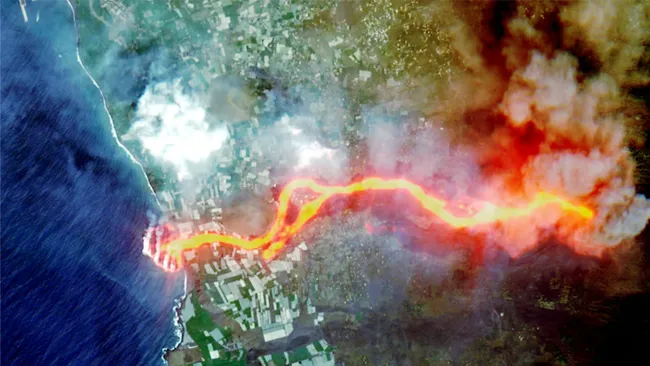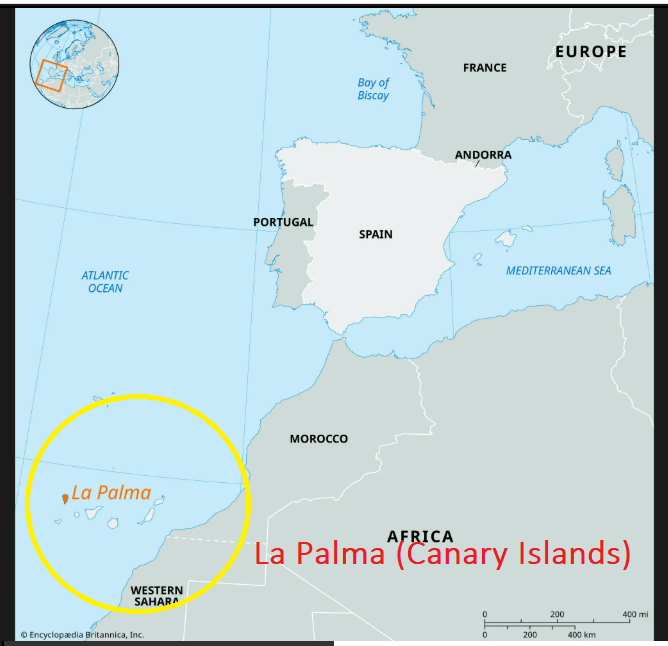'River of fire' unleashes toxic gases as eruption destroys town in La Palma — Earth from space

‘River of Fire’ Destroys Town in La Palma — Toxic Gases Persist Years After 2021 Eruption
In News:
The 2021 eruption of the Cumbre Vieja volcano on the Spanish island of La Palma (Canary Islands) remains one of the most destructive volcanic events in modern European history. The eruption, which began on September 19, 2021, and lasted 85 days until December 13, wiped out the town of Todoque, created new land in the Atlantic Ocean, and unleashed toxic volcanic gases that continue to pose health risks to residents.
Key Facts:
- Location:
Cumbre Vieja ridge, La Palma, Canary Islands — coordinates [28.6212° N, -17.8996° W]. - Eruption Timeline:
- Started: September 19, 2021
- Ended: December 13, 2021
- Duration: 85 days — the longest recorded eruption on La Palma.
- Formation of Tajogaite Cone:
A 200-meter-tall (660 ft) cone, named Tajogaite, formed around the eruptive fissure.
The eruption released approximately 200 million cubic meters (7.1 billion cubic feet) of lava — enough to cover 1,000 hectares (2,500 acres) of land. - Destruction:
- The lava flow completely engulfed Todoque town, erasing it from the map.
- Around 3,000 buildings and large banana plantations were destroyed.
- Estimated economic loss: €700 million (US$780 million).
- 1 fatality reported — due to toxic gas inhalation.
- Over 7,000 residents evacuated safely.
- Toxic Gas Release:
- The lava’s high sodium and potassium content made it unusually alkaline, producing large quantities of sulfur dioxide (SO₂) and hydrogen chloride (HCl) gases when lava met the ocean.
- These gases formed hazardous plumes, creating long-term respiratory hazards.
- Even in 2025, locals report smelling sulfurous gases, and CO₂ pockets remain trapped beneath cooled lava.
- Geological Impact:
- Lava entering the ocean created 430,000 m² (4.6 million sq ft) of new land.
- The eruption’s “river of fire” was visible from space via ESA’s Sentinel-2 satellite.
- The Roque de los Muchachos Observatory, a key astronomy site, had to suspend operations for a week due to volcanic ash.
- Aftermath:
- Infrastructure: The main road between Los Llanos de Aridane and Puerto Naos was destroyed. A new road was completed within two years through the cooled lava field.
- Recovery: The STARMUS Festival (April 2025) marked a symbolic return of tourism to La Palma.
- Ongoing Risk: Volcanic gases remain trapped underground; warning signs are still posted in high-risk areas.
Static Part – Key Concepts
1. Types of Volcanic Eruptions:
- Effusive Eruption: Characterized by steady lava flow (as in La Palma), forming lava fields rather than explosive ash clouds.
- Explosive Eruption: Violent release of gas and pyroclastic material (e.g., Mount Pinatubo, 1991).
2. Toxic Volcanic Gases:
- Sulfur Dioxide (SO₂): Irritates lungs and contributes to acid rain.
- Carbon Dioxide (CO₂): Can accumulate in low-lying areas, causing suffocation.
- Hydrogen Chloride (HCl): Released when lava interacts with seawater, producing corrosive “lava haze.”
3. Lava and Land Formation:
When lava reaches the sea, it rapidly cools, solidifies, and can form new coastal land, as occurred at La Palma — a process known as lava delta formation.4. Volcanic Monitoring:
Agencies like ESA (European Space Agency) and Smithsonian Global Volcanism Program track eruptions using satellite imagery, seismic data, and gas emission measurements.
Significance:
- Demonstrates the devastating local and environmental impacts of prolonged effusive eruptions.
- Highlights volcanic gas hazards as a long-term post-eruption threat.
- Showcases resilience and reconstruction efforts through renewed tourism and scientific engagement.
- Offers key lessons in volcanic risk management, satellite monitoring, and urban planning in volcanic zones.

Updated - May 14, 2025 ; 12: 23 PM | Live Science